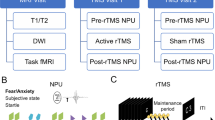Abstract
There is increasing evidence that acupuncture is useful in treating somatic and psychological disorders caused by stress; however, the physiological basis of the effect remains unclear. In the present study, we evaluated the effect of acupuncture on psychological conditions (i.e., anxiety) and prefrontal cortex (PFC) activity. We studied 10 patients with anxiety disorders and measured anxiety levels by means of the State-Trait Anxiety Inventory (STAI), including state anxiety (STAI-1) and trait anxiety (STAI-2). Employing a two-channel NIRS device, we measured oxy-Hb concentration in the bilateral PFC at rest, and evaluated asymmetry of the PFC activity by calculating the Laterality Index at Rest (LIR). The patients were treated by acupuncture at Yui Clinic in Osaka. The treatment significantly decreased the STAI-1 score (p < 0.001), but not the STAI-2 score (p > 0.05). The NIRS measurements indicated the presence of spontaneous oscillations of oxy-Hb in the bilateral PFC at rest before and after the treatment. Notably LIR decreased significantly in 7 out of the 10 subjects (p < 0.01), while 3 subjects showed an increasing tendency. The present pilot study indicates that acupuncture is effective in decreasing anxiety levels in patients with anxiety disorders. Our NIRS data suggest that acupuncture may alter the balance of PFC activity at rest, resulting in relaxation effects. Our NIRS data suggest that acupuncture changes the balance of PFC activity toward left-dominant, resulting in relaxation effects on the patients.
Access this chapter
Tax calculation will be finalised at checkout
Purchases are for personal use only
Similar content being viewed by others
References
MacPherson H, Sinclair-Lian N, Thomas K (2006) Patients seeking care from acupuncture practitioners in the UK: a national survey. Complement Ther Med 14:20–30
Arai YC, Ushida T, Osuga T et al (2008) The effect of acupressure at the extra 1 point on subjective and autonomic responses to needle insertion. Anesth Analg 107:661–664
Middlekauff HR, Hui K, Yu JL et al (2002) Acupuncture inhibits sympathetic activation during mental stress in advanced heart failure patients. J Card Fail 8:399–406
Davidson RJ, Jackson DC, Kalin NH (2000) Emotion, plasticity, cortex, and regulation: perspectives from affective neuroscience. Psychol Bull 126:890–909
Canli T, Zhao Z, Desmond JE et al (2001) An fMRI study of personality influences on brain reactivity to emotional stimuli. Behav Neurosci 115:33–42
Fischer H, Andersson JL, Furmark T et al (2002) Right-sided human prefrontal brain activation during acquisition of conditioned fear. Emotion 2:233–241
Ahern GL, Schwartz GE (1985) Differential lateralization for positive and negative emotion in the human brain: EEG spectral analysis. Neuropsychologia 23:745–755
Ishikawa W, Sato M, Fukuda Y, Matsumoto T, Takemura N, Sakatani K (2014) Correlation between asymmetry of spontaneous oscillation of hemodynamic changes in the prefrontal cortex and anxiety levels: a near-infrared spectroscopy study. J Biomed Opt 19:027005
Ferrari M, Wilson DA, Hanley DF, Traystman RJ (1992) Effects of graded hypotension on cerebral blood flow, blood volume, and mean transit time in dogs. Am J Physiol 262:1908–1914
Hoshi Y, Kobayashi N, Tamura M (2001) Interpretation of near-infrared spectroscopy signals: a study with a newly developed perfused rat brain model. J Appl Physiol 90:1657–1662
Yoon-Hang K (2007) The effectiveness of acupuncture for treating depression: a review. Altern Complement Ther 13:129–131
Pilkington K (2010) Anxiety, depression and acupuncture: a review of the clinical research. Auton Neurosci 157:91–95
Hellige JB (1993) Hemispheric asymmetry. Harvard University Press, Cambridge
Sakatani K, Kitagawa T, Aoyama N, Sasaki M (2010) Effects of acupuncture on autonomic nervous function and prefrontal cortex activity. Adv Exp Med Biol 662:455–460
Acknowledgements
This research was supported in part by Grants-in-Aid for Exploratory Research (25560356) and Strategic Research Foundation Grant-aided Project for Private Universities (S1411017) from the Ministry of Education, Culture, Sports, Sciences and Technology of Japan, and grants from Alpha Electron Co., Ltd. (Fukushima, Japan), Iing Co., Ltd. (Tokyo, Japan) and Southern Tohoku General Hospital (Fukushima, Japan).
Author information
Authors and Affiliations
Corresponding author
Editor information
Editors and Affiliations
Rights and permissions
Copyright information
© 2016 Springer Science+Business Media, New York
About this paper
Cite this paper
Sakatani, K., Fujii, M., Takemura, N., Hirayama, T. (2016). Effects of Acupuncture on Anxiety Levels and Prefrontal Cortex Activity Measured by Near-Infrared Spectroscopy: A Pilot Study. In: Elwell, C.E., Leung, T.S., Harrison, D.K. (eds) Oxygen Transport to Tissue XXXVII. Advances in Experimental Medicine and Biology, vol 876. Springer, New York, NY. https://doi.org/10.1007/978-1-4939-3023-4_37
Download citation
DOI: https://doi.org/10.1007/978-1-4939-3023-4_37
Publisher Name: Springer, New York, NY
Print ISBN: 978-1-4939-3022-7
Online ISBN: 978-1-4939-3023-4
eBook Packages: Biomedical and Life SciencesBiomedical and Life Sciences (R0)




